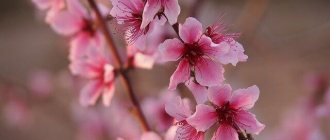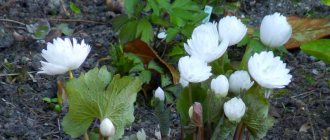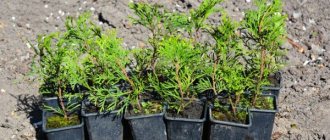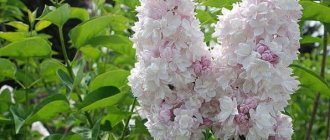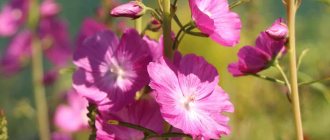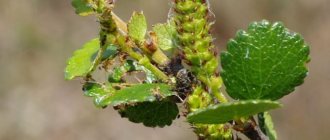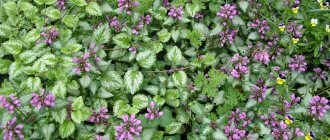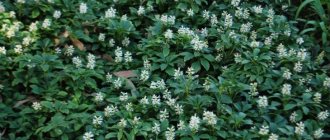Author: Natalya Category: Garden plants Published: September 20, 2018Republished: February 20, 2019Last edits: January 20, 2021
- When to plant
- Growing conditions
Lobularia (lat. Lobularia), or lawn plant, is a genus of flowering plants of the Brassicaceae or Cruciferous family, close to the genus Alyssum (Alyssum). There are five species in the genus, native to the Mediterranean, but only Lobularia maritima, or marine, is cultivated. The genus name comes from the Latin word meaning "pod" and describing the shape of the lawnwort's fruit.
Briefly about cultivation
- Planting: sowing seeds for seedlings - in March, planting seedlings in open ground - at the end of May.
- Flowering: throughout the summer.
- Lighting: bright sunlight.
- Soil: permeable, slightly alkaline or neutral.
- Watering: only needed during periods of prolonged drought.
- Feeding: not needed.
- Reproduction: seed.
- Diseases: powdery mildew and other fungal infections.
- Pests: cruciferous flea beetles, slugs.
Read more about growing lobularia below.
Lobularia can grow in almost any conditions
For this flyer it is enough to choose good lighting. Lobularia are not demanding regarding all other characteristics of the growing site. Find the sunniest, open and warm area for the beauty, avoid damp and cold places - and you will definitely enjoy the beauty of the flowering of this annual plant.
Hardy and unpretentious, lobularia is undemanding to the soil. If the soil is not waterlogged, there is no risk of water stagnation and waterlogging - the place will suit it. Neither acidity, nor nutritional value, nor the composition of the soil is of particular importance for lobularia.
Planting lobularia
This summer plant is planted in small individual holes. The soil can be improved before planting by increasing its looseness and water permeability, but usually simple digging is sufficient.
The optimal planting distance is about 15-20 cm between plants (even for dwarf varieties). Lobularia is afraid of dense plantings, blooms poorly when there is insufficient air circulation and in crowded conditions, and becomes vulnerable to diseases. Therefore, never plant lobularia too densely.
Sea Lobularia, or Seaside Lawnwort (Lobularia maritima). © Sepehr Ehsani
Minimal care for a full-color beauty
Caring for lobularia actually comes down to pruning. No amount of care, even the most careful with systemic watering, will prevent flowering from stopping in an unsuccessful and too hot year, and flowering will not suffer from a lack of moisture. Therefore, lobularia growing in open soil is not watered, except in extremely prolonged hot and dry months as a general maintenance measure and the first weeks after planting seedlings in the soil.
For lobularia, you can forget about feeding. It is not picky about the nutritional value of the soil, does not like excess fertilizers and is content with the supply of nutrients in the soil on ordinary garden soil.
Lobularia is pruned only when the plant stops flowering. After the first stage of flowering is completed, it needs to be cut low. Lobularia will quickly begin to grow, restore lush bushes and, on the eve of autumn, will bloom again, even more profusely. Many modern varieties do not require pruning and resume flowering on their own after air temperatures drop to comfortable levels. When purchasing seedlings or seeds, be sure to check this parameter, because lobularia may not even need such minimal care.
A little more difficult is caring for potted and container lobularias. These beauties will need regular watering and weekly fertilizing, and timely shortening of thinned or loose shoots. But even in potted form, lobularia is not as capricious as other summer plants.
Botanical description
Seaside lawnweed is an annual plant that is a compact or spreading densely branched bush up to 30 cm high with small grayish-green linear-lanceolate leaves with white hairs and small white or pale purple flowers collected in brushes with a honey aroma. Lobularia flowering lasts from May to mid-autumn, but is interrupted during dry and hot summers. The fruit of Lobularia maritima is an oval-shaped pod with a sharp apex, in which orange-brown or yellow seeds ripen.
Features of cultivation
Sea lobularia (Lobularia maritima), also called “marine allisum,” belongs to the Brassica family. People also know other names for this garden flower - lawnwort, alyssum, alyssum. The plant's homeland is the Mediterranean , however, there are no problems with its cultivation in areas with colder climates.
Externally, lobularia is a plant with branching stems up to 20 cm long, which form lush and dense bushes. Small dark green lanceolate-shaped leaves are located close to each other. Lobularia flowers are white, pink or light purple in color and form elongated inflorescences in the form of brushes.
For decorative culture, the most illuminated, elevated and open side of the garden plot is suitable. In cold, shady places or lowlands, a garden flower will experience constant stress and grow poorly. Lobularia can be planted in soil of any type and composition: in this regard, the crop is completely unpretentious.
The only requirement is that the land should not be too waterlogged or swampy.
Growing lobularia from seeds
How to sow seeds
Growing lobularia begins with sowing seeds. How to sow lobularia for seedlings? Using a damp toothpick, seeds are spread over the surface of a loose and light, previously disinfected and moistened substrate placed in a seedling box. Sowing is done in March. The container is covered with glass or film and placed in a warm, bright place, shaded from direct sunlight. To keep the substrate slightly moist, it is sprayed with settled water at room temperature from a spray bottle. Every day, the film is briefly removed from the crops to ventilate and remove condensation. Shoots can appear in as little as a week and a half.
Seedling care
When the seeds begin to germinate, the covering of the crops is removed, and the temperature in the room is lowered by 2-3 degrees. At the stage of development of seedlings, pairs of true leaves are picked into separate containers. Caring for seedlings at this stage consists of moderate watering and loosening the soil around the seedlings.
- Ratibida: planting and care in open ground
Be careful with watering: excessive moisture can lead to the fungal disease blackleg, from which small lobularia lay down and die.
A relative of lobularia is alyssum and how to grow it
Two weeks before planting in the flower garden, the seedlings are subjected to hardening procedures: they are taken out into the open air for a while, increasing the duration of such walks daily.
Sowing seeds
For sowing, seeds are used that are stored for no more than 3 years in suitable conditions; they are the ones that have the greatest germination rate. The first shoots appear within 10-15 days if the container with soil is stored in suitable conditions. Plastic containers can be used as containers for growing seedlings; they are mini-greenhouses in which a greenhouse effect is created. Light soil with good air exchange is suitable; river sand or peat can give it these properties. Growing lobularia from seeds requires some knowledge. For example, before sowing, the soil should be moistened and a manganese solution should be added for disinfection.
Only after this, shallow grooves are drawn, seeds are sown on the surface of the soil, and a small layer (no more than 0.5 mm) of sand is sprinkled on top. The container is covered with a transparent lid on top and sent to a bright, warm place. Caring for seedlings involves daily ventilation and spraying the soil with a spray bottle if it is dry. Over-watering should be avoided.
The best time for sowing is the first half of March, since it is at this time that daylight hours increase and there is a high probability that the seedlings will grow healthy and strong.
You can sow seeds on the surface of the snow; as it melts, it will draw the seeds into the soil to the required depth, and as a result of short-term cooling, stratification will occur, which guarantees the rapid growth of the seed.
Planting lobularia in open ground
When to plant
Lobularia seedlings are planted in open ground at the end of May, when the threat of night frosts has passed, the soil has warmed up and warm weather has established. Lobularia grows well in open sunny areas, but you should not plant it where snow does not melt for a long time and water stagnates.
In the photo: Lobularia flowering in open ground
How to plant
Marine lobularia is not particularly demanding on the composition of the soil, but it is desirable that it be permeable, neutral or slightly alkaline. When preparing the site, it is enough to simply dig up the ground and level its surface. Seedlings are planted in holes located at a distance of 15-20 cm from each other: lobularia does not like crowded spaces. After planting, the surface is compacted and watered. Lobularia blooms from seeds 40 days after germination.
General description with photo
Lobularia is a herbaceous flowering plant of the Cruciferous family. Despite the fact that there are perennial varieties in its genus, only one annual species has been cultivated and is actively used, which received the name Lobularia maritima in the modern botanical classification. In nature, it grows in places with far from the most fertile soil - on rocky and pebble landscapes, in mountain crevices, on rocky embankments. Planting lobularia in open ground and caring for it at home should be done taking this feature into account.
The height of the bush and its shape depend on the varietal variety, but usually does not exceed 40 cm. Moreover, the smaller and more compact the plant, the denser the clump it forms. Tall varieties have a loose, flattened shape, while dwarf varieties have the appearance of a dense ball. The shoots are thin, highly branched. During flowering, small leaves become almost invisible behind a lush cloud of small but numerous flowers. The inflorescences are racemose, dense, dense. The range of colors is varied - from white and all shades of pink to dark lilac and violet. On one specimen, new buds can simultaneously form in the upper part and seeds ripen and fall off in the lower part.
Lobularia is prone to self-sowing, and the fallen seeds germinate and sprout not only in the warm Mediterranean region, but also in the climate near Moscow.
Caring for lobularia in the garden
Growing conditions
Planting lobularia and caring for this ornamental plant in open ground will not seem tiresome to you. You will need to water the flower garden from time to time, loosen the soil, remove weeds and mow the lawn.
The plant is pruned when the first stage of flowering is completed, and the stems are cut as low as possible. After pruning, the lobularia will begin to grow, quickly recover, and on the eve of autumn it will bloom again, and even more magnificently than the first time.
- Campsis: planting and care, propagation, types and varieties
Many new, recently bred varieties do not need pruning and will resume flowering on their own as soon as the heat subsides.
Planting and caring for Arabis in a flower bed
Watering and fertilizing
There is no need to water lobularia, unless an abnormally hot and dry summer comes. However, even with systematic watering and the most careful care, you will not make this plant bloom in extreme heat. There is also no need to fertilize the lawn.
In the photo: Growing lobularia from seeds
Pests and diseases
Lobularia is one of the most disease- and pest-resistant plants. She runs the risk of getting sick only as a result of improper planting: lobularia growing too densely is sometimes affected by powdery mildew and other fungal diseases. Remove the affected specimens and treat the remaining plants with a fungicide solution.
Among the pests that pose a danger to lawns are slugs and the cruciferous flea beetle, a malicious pest of cabbage crops.
Fleas are destroyed by treating the flower garden with Decis, Actellik, Karate, Bankol or Aktara.
It is better to collect slugs by hand or lure them into a trap - a glass jar buried up to the neck in the ground, one-third filled with beer or fermented compote.
Landing in the ground
Lobularia is planted in groups to create a uniform flower cover; caring for a perennial plant will only bring pleasure if you choose a sunny area, not shaded by tree crowns, with dry, fertilized soil. Flowers respond well to the heat emanating from heated bricks and stones, so they grow well near a paved path or border.
Before planting, dig up the soil, add peat or compost, then follow the following procedure:
- We dig holes, keeping an interval of 40-50 cm. The flower grows well, so it is not worth planting too closely.
- We take each plant out of the cup, trying not to damage the earthen ball, and plant one in each hole.
- Cover with soil and water generously.
- Mulch with peat or humus. Mulch prevents weed growth and protects the soil from excessive drying out.
6-7 weeks after planting, with careful care, the first flowers will appear on the plant.
Types and varieties
The cultivated species of marine lobularia has several popular varieties, and these, in turn, have become the basis for the development of new varieties.
- When to dig up gladioli after flowering
The Bentham variety is a plant up to 40 cm high with white flowers. The most famous varieties of this garden form are:
- Weiss Risen - a lawn plant up to 35 cm high with large white flowers that can be used for cutting;
- Schneersturm is a variety up to 25 cm high with large white flowers.
In the photo: How lobularia blooms
The variety is compact - a plant up to 15 cm high. The best varieties:
- Violetkenigin is a compact, densely branched lobularia up to 15 cm high with purple flowers;
- Carpet of Snow is a variety up to 15 cm high with very fragrant white flowers.
The prostrate variety is represented by the following varieties:
- Schneeteppich is a densely branched compact bush up to 10 cm tall with white flowers collected in short racemes;
- Koenigstepich - lobularia of the same height, but with purple-violet flowers;
- Rosie O'Day is a variety with deep pink flowers.
In the photo: Lush flowering of lobularia in the garden
The variegated variety is a plant up to 15 cm high with leaves bordered with a yellowish-white stripe and small light purple or white flowers:
- Tetra Schneetraben is a bush up to 25 cm high, blooming profusely and continuously with large white inflorescences.
The following varieties of seaside lobularia are popular:
- Oriental Knight - a bush about 10 cm high with purple-violet flowers;
- Paletta is a variety of plants of the same height with inflorescences, the color of which can be almost white, pinkish, crimson, lilac and brownish;
- Samen is a plant up to 10 cm high with light salmon flowers;
- Snow Crystals - bushes up to 6-8 cm in height with large white flowers;
- Vanilla cloud is a plant reaching a height of 30 cm with white inflorescences;
- Tiny Tim - lobularia only up to 8 cm in height with excellent ground cover qualities and white flowers;
- New Apricot is a variety with a unique light apricot color of flowers.
Also in demand in garden floriculture are the Easter Bonnet series and variety mixtures (a series of 5 varieties of lobularia of different colors up to 8 cm high), Snow Queen (plants up to 10 cm high with flowers of different colors) and Golf (tiny bushes up to 6 cm high with white flowers, pink, purple and other colors, including pastels).
Popular varietal varieties with photos
Lobularia cannot boast of species diversity, but its varietal lines make it a good choice for growing at home as a pot crop and in open ground. The color range is varied at first glance, but in fact it is limited to the classic “phlox” colors - white, pink, lilac, lilac. But based on this limited choice, breeders are creating more and more new varieties and hybrids, actively expanding the original color palette.
Lobularia marine
A basic variety adapted for cultivation in the Russian climate. Forms low, on average about 30 cm, dense bushes with branched shoots and small lanceolate pubescent leaves. Small buds are painted snow-white or light purple. This herbaceous annual can produce both perfectly even compact crowns and loose bushes with long lodging shoots. It has an atypical honey aroma and a discreet, but very cute appearance.
With the classic timing of planting seedlings, the first flowering starts at the end of May. The subsequent pause in flowering or its absence is determined by both varietal characteristics and weather conditions of a particular year.
In cool and rainy summers, lobularia blooms are likely to be non-stop. If the summer turns out to be dry and extremely hot, by the end of July there may not be a single flower left on the bushes. This feature can be attributed both to the disadvantage of the plant and to its advantages, since repeated flowering becomes even more abundant and reaches its maximum decorative value with the onset of autumn.
There are three main forms of marine lobularia: compact, variegated and prostrate with ampelous creeping shoots.
The best varieties and hybrids of this species
- "Salmon". A very short variety of salmon color with a small and lush crown, not exceeding 10 cm.
- "New Apricot". A characteristic feature of the variety is its very light and atypical apricot color of the inflorescences.
- "Schneesturm". A fairly tall but neat bush with large snow-white flowers.
- "Carpet of Snow". The crown is up to 15 cm, spherically compact, with a very rich aroma.
- "Paletta". A dwarf variety that is interesting for its mixed colors in the entire palette of phlox colors.
- "Wise Rise" A large-flowered variety that can be grown as a cut flower.
- Tiny Tim. Due to its miniature growth, it is grown as a ground cover, producing snow-white foam inflorescences.
- "Konigsteppin". Dark-flowered variety.
Varieties of seaside lobularia
After alyssum began to be grown as an ornamental flower, breeders developed many varieties that differ in bush height, flowering time and other characteristics. Thanks to their work, new species appeared, more vibrant and spectacular than in the wild.
Aphrodite
Alyssum maritimum Aphrodite is a compact plant, the bush of which is 15 cm high and 20 cm wide. The variety has a huge variety of shades - from soft pink and light lavender to purple and wine.
The best place for the Aphrodite variety is in the foreground of the composition.
Esther Bonnet Deep Rose
Alyssum maritimum Easter Bonnet Deep Rose blooms profusely from May to November. The diameter of the blossomed buds is 15 mm. The color of the petals is deep pink. Plant height is from 10 cm to 20 cm. The variety looks great in flower pots and baskets because it forms a ball of inflorescences.
Esther Bonnet Deep Rose has one of the longest flowering periods
Wonderland Blue
The variety of sea alyssum Wonderland Blue (Alyssum maritimum Wonderland Blue) is one of the most compact. The height of the creeping bushes is up to 10 cm. The flowers are blue or blue in color, genetically aligned according to the size of the petals. The variety is one of the early ones; the first buds bloom a month and a half after sowing.
Alyssum Wonderland Blue is used for single and group plantings
Violet Koning
Alyssum maritimum Violet Koning has a small spherical bush 15 cm high. The flowers are bright purple. The variety is a hanging variety; most often it is grown in hanging flowerpots.
Flowering of Alyssum marine Violet Koning lasts from May to autumn
Rosie O Day
Alyssum maritimum Rosie O Day forms a carpet of white and pink inflorescences. Plant height is from 8 cm to 10 cm. The buds are very tender and fragrant. Flowering begins in June and continues until frost.
The alyssum variety Rosie O Day loves well-lit areas and well-drained soil.
White sea alyssum
A lot of snow-white varieties of alyssum have been bred. The combination of emerald green foliage and light petals looks very impressive. Among the most popular:
- Alyssum maritimum Primavera Princess;
- Alyssum maritimum Snow Crystals;
- Alyssum maritimum Silver Stream;
- Alyssum maritimum Snow Princess;
- Alyssum maritimum Tiny Tim.
Description of lobularia
Find out when to plant seeds so that beautiful lobularia appears. Here we will tell you what growing from seeds should be like. But first, let's offer a description of this flower. Sea lobularia or seaside lawnwort is a herbaceous plant. It is capable of forming beautiful spreading or, on the contrary, compact, ideal in shape, dense and lush bushes.
Their height, as a rule, is no more than 30 centimeters.
And due to the very dense branching, the bush of the plant from the outside appears voluminous and powerful. The leaves of the plant are small, lanceolate in shape and pale green in color. They are located very close to each other. The inflorescences of lobularia cannot be called very spectacular. But still, they are quite cute.
The flowers have the correct shape, and due to their color they seem very bright and catchy. have a delicate honey aroma.
After flowering, fruits begin to appear, resembling oval pods of brick or yellow color. The traditional color range of lobularia is limited to lilac, white, or purple flowers. But now, varietal crops with new interesting colors are being used more and more often.
When does lobularia bloom?
At the time of sowing lobularia for seedlings, its flowering begins in the last ten days of May, early June. And flowering is completely completed around the end of October, at a time when the entire garden plot begins to embrace the anticipation of cold weather and winter. This leads to a stop in flowering even of persistent, late varieties of perennial crops. The absence or pause in flowering, as a rule, depends on the weather.
- If the summer turns out to be cold and very rainy, then the plant will bloom tirelessly.
- But if the weather conditions turn out to be hot, then flowering may stop altogether by the end of July. But this pause will contribute to a second, very abundant wave of flowering of the plant.
- It is imperative to trim the lobularia so that the second wave of flowering can definitely occur.
Plant in landscape design
A fragrant carpet of lobularia will decorate border plantings, rock gardens and rock gardens. Despite its miniature size, the plant forms a very elegant, rich carpet. The flower delights with its rich colors. An experienced gardener can experiment with patterns using different varieties.
The honey aroma will delight you near gazebos and verandas. The insects attracted by it will not leave fruit trees aside. Lobularia is actively used for hanging plantings, decorating terraces and balconies. It is good in combination with phlox, tulips, forget-me-nots and irises.
Diseases and pests
Diseases affect marine lobularia when planted on contaminated soils, violation of agricultural practices and thickening. To combat powdery mildew, rot, white and brown rust, fungicides, Bordeaux mixture, Ordan and Oksikhom are used.
No less danger threatens the sea alyssum from the cruciferous flea beetle, white moth and cabbage moth. You can get rid of insect pests using traditional methods (spraying with a solution of acetic acid, wood ash, pepper, tobacco dust) and using chemicals (Arrivo, Inta-Vir, Phytosan, Cyperon).
When affected by viral mosaic, plants are removed because the disease cannot be treated.
Planting lobularia seeds: step-by-step instructions
You can purchase seeds at any flower shop by choosing the color variation you like.
Depending on the variety, lobularia flowers can be snow-white, pink, crimson, light or dark lilac, purple, brownish. To collect seeds from an adult bush for further planting, proceed as follows:
- Do not water the flowers for several days.
- Spread a light cloth or paper on the ground.
In the evening, collect the spilled seeds, dry them for a day and pour them into a paper bag.
Table 1. Popular varieties of lobularia and their shades
| Variety | Description |
| "Vanilla Cloud" | Lobularia blooming white. The height of the plant reaches thirty centimeters. |
| "Salmon" | A plant with light salmon flowers, reaching a height of ten centimeters. |
| "Oriental Knight" | Purple-violet lobularia, whose height is about eight centimeters. |
| "Paletta" | Lobularia is a multicolor plant, the inflorescences of which can have shades of white, pink, bright crimson, and purple. Height - up to ten centimeters. |
| "Rosie O Day" | Pale pink lobularia, compact in size - six to eight centimeters in height. |
| "Snow Crystals" | Lobularia with large, snow-white flowers, growing in height up to six to eight centimeters. |
A combination of different varieties of lobularia in one flowerbed
Seed preparation
Before planting, lobularia seeds are soaked for a day in any solution that stimulates growth (for example, in Epin). Having taken out the seeds after 24 hours, they need to be dried for another day, poured onto thick paper and placed away from sunlight.
Lobularia seeds
Preparing the container and substrate
While the seeds are drying, you need to prepare containers or garden boxes for seedlings where the young lobularia will grow. Any soil with a moderately acidic composition (soil for flowering plants) is suitable for planting. The substrate must be pre-moistened and thoroughly loosened.
When the seeds are ready for planting, shallow furrows (about a centimeter to one and a half deep) need to be made in the soil, at a distance of two to three centimeters from each other. It is convenient to sprinkle the seeds from a folded sheet of paper. There is no need to sprinkle seeds too often; one or two for every centimeter is enough.
Planting lobularia seeds
Caring for planted seeds
After the seeds are placed in the ground, the furrows are covered with earth, and the containers are covered with glass or thick film. Boxes with future seedlings are placed in a warm place, once a day the film or glass is lifted to spray the crops with water from a spray bottle. The soil should always be slightly moist. The first shoots can be detected quite quickly - in a maximum of a week.
The first sprouts of lobularia
When the first tiny leaves unfold, the film or glass is removed. The planting is carefully watered every two to three days. When the lobularia grows two or three true leaves, it’s time for picking.
Lobularia picking
You need to prepare in advance separate cups (peat pots work well) where the seedlings will be planted. Lobularia are planted not singly, but in two or three shoots together. It is necessary to time the seeds so that the picking period falls at the end of April, since in mid-May lobularia can be planted on open soil. However, planting is carried out only when night frosts completely stop.
Lobularia is ready for picking
Features of correct plant picking
Planting lobularia in the soil
A flowerbed or other place where lobularia will settle should be located in the sun. Planting sprouts in open soil is possible when the sprouting bushes reach a length of five to eight centimeters (depending on the variety). The flowers need to be transferred to the ground along with a lump of earth from the pot, carefully removing the plant. If lobularia are planted in peat pots, they are completely immersed in the ground; there is no need to remove the rhizomes from them.
Lobularia before planting in the ground
When planting lobularia bushes, you need to leave a distance of 15-20 centimeters between them so that the plant can develop fully without interfering with its “neighbors”.
Description of the plant
Lobularia is a herbaceous perennial and annual plant belonging to the Cruciferous family.
The birthplace of the flower is the Mediterranean. It is most likely to be found in moderately fertile, well-drained soil with neutral acidity. Lobularia flowers are undemanding to lighting; they grow quietly both in direct sunlight and in diffused light, but in open areas the flowering is more intense and bright.
Lobularia reproduces by seeds. The culture grows annuals, up to 40 cm tall and up to 15 cm wide, low bushy plants, compact, densely branched.
The leaves are narrow, lanceolate, fleecy, elongated, dark green, alternate in arrangement on the stem, most of which are concentrated in the lower part of the plant. During the flowering period, the stem becomes stiffer and more branched.
Small white and blue flowers collected in cross-shaped, umbrella-shaped spherical inflorescences. One flower contains four round petals. The aroma is strong, honey very aromatic, attracts many butterflies and bees.
After flowering, a fruit is formed - an oval pod with a sharp end. Due to the shape of which the plant received the name lobularia, from the Latin lobulus, which means a small pod. One pod contains about 3,000 small seeds, with different shades of yellow or brown, that remain viable for 3 years.
Many gardeners equate lobularia and alyssum, while others believe that combining the names is in vain. They belong to the same family and are very similar in appearance. Alyssum is a low perennial plant, and marine lobularia is an annual variety.
When does lobularia bloom?
The plant is able to delight with its lush flowering from the beginning of summer until the very end of autumn, until the first frost. During periods of severe drought and hot weather, flowering stops. As soon as the temperature becomes comfortable, the bush will bloom again.

